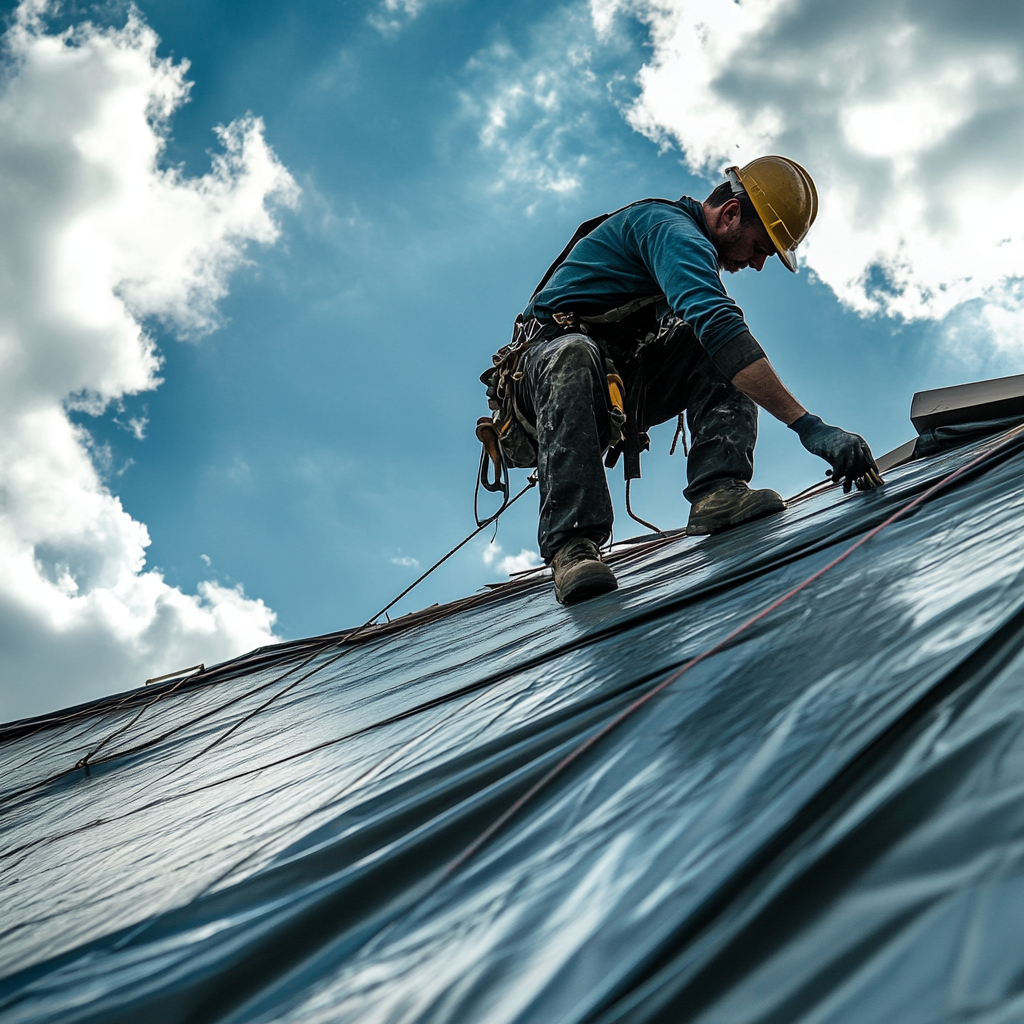Why is tarping a roof so important? Well, picture this: You’ve weathered a storm, but your poor old roof hasn’t fared so well. There are a few shingles missing, maybe even a hole where you can see sky where no sky should be. It’s not exactly inviting in a family of squirrels or letting buckets of rainwater flood your attic, but that roof isn’t healthy, and it’s certainly not protecting your home like it should.
That’s where tarping comes to the rescue! A simple yet efficient solution, tarping helps keep your home safe and dry while you work out the next steps for repair. This piece is your straightforward guide to understanding tarping, why it’s such an important rapid response to roof damage, and how it’s done.
What is Tarping and its Purpose
The purpose of tarping is simple: To help keep your home safe and protected after your roof has taken a beatdown. Whether it’s a nasty storm, an unfortunate fire, or an unforeseen incident (tree fall, anyone?), you need to prevent further damage from occurring inside your home. With a properly installed tarp, you can keep the elements right where they belong—outside! This means no more water leaking through your ceiling, no critters sneaking in, and definitely no additional harm to your precious abode. Think of tarping as a roof’s best friend in a time of crisis! The best part? Tarping is a quick and relatively inexpensive solution that can prevent costly repairs down the line.
When to Tarp a Roof
They do say timing is everything, and when it comes to tarping, they’re absolutely right. Quick action after damage occurs is key. If you’ve noticed a few pesky leaks after a hefty rainstorm, or worse, hail has left your roof looking like it’s been in a boxing match, it’s time to consider tarping.
It’s not just weather that can wreak havoc on our roofs, though. Unforeseen incidents such as fire damage—or even an errant tree branch giving your roof an unwelcome surprise visit—also warrant swift action. In fact, anytime there’s significant damage to your roof that exposes your home to the weather or potential intruders (be they four-legged or winged), tarping is a smart, effective move.
Remember, tarping is a temporary measure, a shield of sorts to keep further damage at bay while you figure out the next steps for repair. So while it won’t fix the actual damage to your roof, it’s a terrific stop-gap solution to keep a dodgy situation from going downhill.
DIY vs. Professional Roof Tarping
When it comes to tarping a roof, you may find yourself confronted with the big question: DIY or call in the professionals? It might seem like a standard operation, something that can be handled with a trusty ladder and a bit of elbow grease. But when it comes to the well-being of your family and the safety of your home, it’s worth weighing up your options thoroughly.
Let’s start with the DIY route. Yes, it could save you a dime, and for the particularly handy, it might seem like an exciting challenge. But hold up – have you considered the safety aspects? Climbing onto a roof, especially one that’s just weathered severe damage, isn’t for the faint-hearted. It requires careful planning, adequate safety measures, and a certain level of physical fitness. Not to mention, a half-done job could lead to more problems (think ineffective water barrier) potentially leading to more damage.
On the other side of the coin, we have professional roof tarping services. Yes, it does involve cracking open the wallet, but the pros far outweigh the cons. To start with, professionals are trained to do this job safely and efficiently, meaning you can stay put on safe ground. This might be particularly reassuring to those with insurance requirements to consider. Plus, you can rest assured the job will be done properly and thoroughly, ensuring your home is effectively sealed off from further damage.
To wrap up, while DIY might be tempting, especially for the keen handypeople out there, tarping a roof is a serious task that requires serious consideration. Your roof is the cornerstone of your home’s protection after all, so it isn’t a decision to be made lightly.
The Process of Tarping a Roof by Professionals
Choosing professionals over DIY becomes more compelling once you understand the detailed, careful process involved in expertly tarping a roof. Let’s take a moment to unwrap this process and perhaps you’ll see why it’s best left to the seasoned pros.
- Evaluating The Damage: Before the tarp rolls out, professionals first assess the damage. They check the severity, location, and size of the damaged area to determine the best tarping approach.
- Choosing The Right Tarp: Tarps come in a variety of sizes and quality grades. Professionals will select the most suitable tarp for the job, usually one that’s larger than the damaged area to ensure a proper seal.
- Securing The Tarp: Having chosen the appropriate tarp, it’s time to secure it. The tarp is unfurled across the damaged section and affixed securely to prevent it from being blown away or displaced. Great care is taken to ensure all corners are well fastened.
- Tidying Up: Any remaining loose ends are trimmed away, ensuring that the tarp blends as seamlessly as possible with the rest of the roof.
- Final Inspection: The final and arguably the most critical step is a rigorous inspection. This is to confirm that the tarp is well-fastened and that it covers the damaged area fully with no overlooked or exposed gaps.
This meticulous process ensures your home stays protected in the aftermath of roof damage. The experts execute each step with precision, safety precautions, and the mission to provide a temporary fix to the roof until a permanent repair can take shape. Therefore, it is evident why this detailed operation demands the skills of trained professionals.


